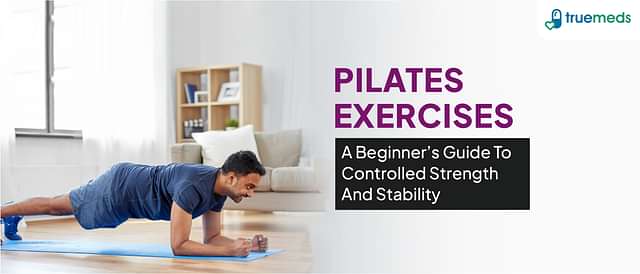Lunges: Key Benefits for Strength and Flexibility
Last updated on : 18 Mar, 2025
Read time : 8 min
Lunges are a highly versatile and effective exercise that offer numerous benefits for overall health and fitness. This unilateral exercise targets multiple muscle groups simultaneously, making it an essential component of any strength training or rehabilitation programme. By incorporating lunges into your workout routine, you can enhance your lower body strength, improve flexibility, and boost your athletic performance. In this article, we will explore the key benefits and mechanics of lunges to help you understand their significance and how to perform them correctly.
What Are Lunges?
Lunges are a form of resistance exercise that involve a series of coordinated movements to strengthen the lower body and core and improve overall balance and flexibility. During a lunge, one leg is extended forwards while the other remains behind, creating a unilateral movement that works multiple muscle groups, including the gluteals, quadriceps, hamstrings, and core muscles.
This exercise can be modified to suit various fitness levels through variations. Each variation targets different aspects of the lower body and core, ensuring comprehensive muscle development and functional fitness.
| Did You Know: Lunges trace back to ancient military training and athletics. Warriors and soldiers historically practiced lunges to build leg strength, balance, and endurance, as these movements mimic walking strides essential in combat and travel. Lunges also appear in traditional calisthenics and European gymnastics of the 19th century, where they became staples for conditioning and functional fitness. In the 20th century, lunges gained popularity in weightlifting, sports training, and fitness routines, recognised for their versatility in building strength and flexibility. |
Types of Lunges
Lunges are a versatile exercise that can be adapted to suit different fitness levels and goals. Some of the main types of lunges include:
- Forward Lunge: Step forward with one foot, lowering your body until the back knee nearly touches the ground. Targets the quadriceps, hamstrings, glutes, and core.
- Backward Lunge (Reverse Lunge): Step backwards instead of forwards, emphasising the glutes and hamstrings more than the quadriceps.
- Static Lunge (Split Squat): Stand in a split-stance position without stepping out or returning. Easier on the knees and works the quadriceps, hamstrings, and glutes.
- Lateral Lunge: Step out to the side, engaging the adductors and medial quadriceps more than other lunge variations.
- Curtsy Lunge: Step back with one leg, crossing it behind the other to target the gluteus medius and hip adductors.
Each lunge variation offers a unique way to engage different lower body muscle groups. Incorporating a variety of lunges into your routine can help you reap the many benefits of this exercise.
Benefits of Lunges Exercise
Lunges provide numerous advantages for strength, flexibility, and overall lower body development. Some of the key benefits include:
- Strengthens Lower Body Muscles: Lunges effectively target and strengthen the quadriceps, hamstrings, glutes, and calf muscles. Different variations can emphasise different muscle groups for a comprehensive lower body workout.
- Improves Balance and Coordination: Many lunge variations, such as walking lunges, require balance and coordination. Regularly practising lunges can help improve overall stability and reduce the risk of falls.
- Enhances Flexibility: Lunges help improve hip flexibility and range of motion, particularly in the hips and knees. The static lunge and elevated reverse lunge are especially beneficial for this purpose.
- Engages the Core: Maintaining proper form during lunges requires core stability, which engages the abdominal muscles and improves core strength.
- Provides Cardiovascular Benefits: Dynamic lunge variations, like walking lunges, can increase heart rate and provide a cardiovascular workout, making lunges a great addition to a full-body fitness routine.
- Develops Functional Strength: Lunges mimic many daily activities, such as walking, climbing stairs, and getting up from a seated position. This functional strength can improve daily mobility and reduce the risk of injury.
- Aids in Injury Rehabilitation: Certain lunge variations, like the static lunge, can be modified to be easier on the knees, making them an excellent option for individuals recovering from knee injuries or those with knee pain.
Also Read: Home Remedies for Knee Pain
How to Perform a Lunge
Performing lunges correctly is essential to maximise their benefits and minimise the risk of injury. Here are the key steps to execute a lunge properly:
- Stand with your feet hip-width apart, hands on your hips or by your sides.
- Take a large step forward with one leg, ensuring that your front foot lands flat on the ground and your back heel rises.
- Keeping your trunk upright and core engaged, bend both knees to approximately 90 degrees. Ensure the middle of your front knee is directly above your ankle, and your back knee is almost touching the ground.
- Lower yourself down slowly, maintaining proper posture, and then forcefully push off from your front leg to return to the starting position.
- Engage your core muscles throughout the exercise to maintain balance and stability.
- Repeat the process with the other leg to ensure balanced muscle development.
Once you have mastered the basic lunge form, you can consider adding weights to further challenge your muscles and enhance the intensity of the exercise.
Adding Weights to Lunges
Incorporating weights into your lunge routine can effectively target your muscles more aggressively and enhance the overall effectiveness of the exercise. Here are some pointers on how to add weights to your lunges:
- Use dumbbells, a barbell, or even kettlebells to add resistance. Start with manageable weights and gradually increase as you build strength.
- If using dumbbells, hold one in each hand by your sides. For a barbell, place it across your upper back or hold it in front of your chest.
- Ensure that adding weights does not compromise your form. Keep your back straight, core engaged, and knees properly aligned throughout the exercise.
- Consider different variations such as walking lunges with weights or plyometric lunges for added challenge and dynamic movement.
- Pay extra attention to maintaining balance and control, as the added weight increases the demand on your stabiliser muscles.
Incorporating Lunges Into Your Workout Routine
To maximise the benefits of lunges and ensure proper form, consider the following tips when adding them to your workout plan:
- Begin by mastering the basic forward lunge. Start in a standing position, step forward with one leg, and lower your body until both knees are bent at approximately 90 degrees, keeping your trunk upright and core engaged throughout the movement.
- Vary your lunge exercises by including forward, reverse, side, and walking lunges to target different muscle groups and prevent plateaus.
- Aim for three to four sets of 15 to 20 lunges per leg, adjusting the number of sets and repetitions based on your fitness level and goals.
- Progress the difficulty of your lunges by incorporating weights, jumping, or plyometric movements, or use support like a wall or sturdy object for balance if you are a beginner.
- Maintain consistency in your lunge workouts, performing them regularly to see continuous improvements in strength, flexibility, and overall fitness.
By following these guidelines, you can effectively integrate lunges into your workout routine and experience the numerous benefits they offer for your strength, flexibility, and overall well-being.
In summary, lunges are a versatile and highly beneficial exercise that should be a fundamental component of any fitness routine. They offer a wide range of advantages, from strengthening major muscle groups to improving flexibility, balance, and coordination. By incorporating lunges into your workout plan with proper form and consistency, you can enhance your overall fitness, athletic performance, and daily functioning. Whether you are a beginner or an experienced athlete, lunges are an essential exercise that can help you achieve a stronger, more balanced, and healthier body.
FAQs
Lunges are primarily a strength training exercise that targets the leg muscles. However, when performed in high-intensity routines, they can also provide cardiovascular benefits.
Both lunges and squats offer unique benefits. Lunges are better for addressing muscle imbalances and improving balance, while squats may be preferable for those who feel more stable in that position.
Yes, lunges can help burn fat by building lean muscle in the lower body, which increases resting metabolism and aids in reducing overall body fat.
It is generally not recommended to do lunges every day, as strength training exercises require recovery time. Performing lunges 2-3 times a week is more typical and effective.
Lunges can help tone and strengthen the muscles in the thighs, including the quadriceps, hamstrings, and adductors. However, slimming the thighs may require overall weight loss in addition to the lunges exercise.
No, lunges do not reduce the buttocks. In fact, they help strengthen and tone the gluteal muscles, leading to a more toned and stronger buttock area when performed regularly.
References
- https://pmc.ncbi.nlm.nih.gov/articles/PMC9925109
- https://pmc.ncbi.nlm.nih.gov/articles/PMC9311947
- https://journals.lww.com/nsca-jscr/fulltext/2009/05000/forward_lunge__a_training_study_of_eccentric.36.aspx
- https://www.researchgate.net/publication/378872384_Effects_of_lunges_inserted_in_walking_eccentric_walking_on_lower_limb_muscle_strength_physical_and_cognitive_function_of_regular_walkers
Disclaimer
Our healthcare experts have carefully reviewed and compiled the information presented here to ensure accuracy and trustworthiness. It is important to note that this information serves as a general overview of the topic and is for informational purposes only. It is not intended to diagnose, prevent, or cure any health problem. This page does not establish a doctor-patient relationship, nor does it replace the advice or consultation of a registered medical practitioner. We recommend seeking guidance from your registered medical practitioner for any questions or concerns regarding your medical condition.
Popular Articles
Recommended Articles
Recent Articles
Top-Selling Medicines:
...View more
Top-Selling OTC:
...View more
Company
About UsHealth ArticleHealth StoriesDiseases & Health ConditionsAll MedicinesAll BrandsNeed HelpFAQSubscribe
Registered Office Address
Grievance Officer
Download Truemeds

Contact Us
Our customer representative team is available 7 days a week from 9 am - 9 pm.
v3.7.8
Our Payment Partners



























































